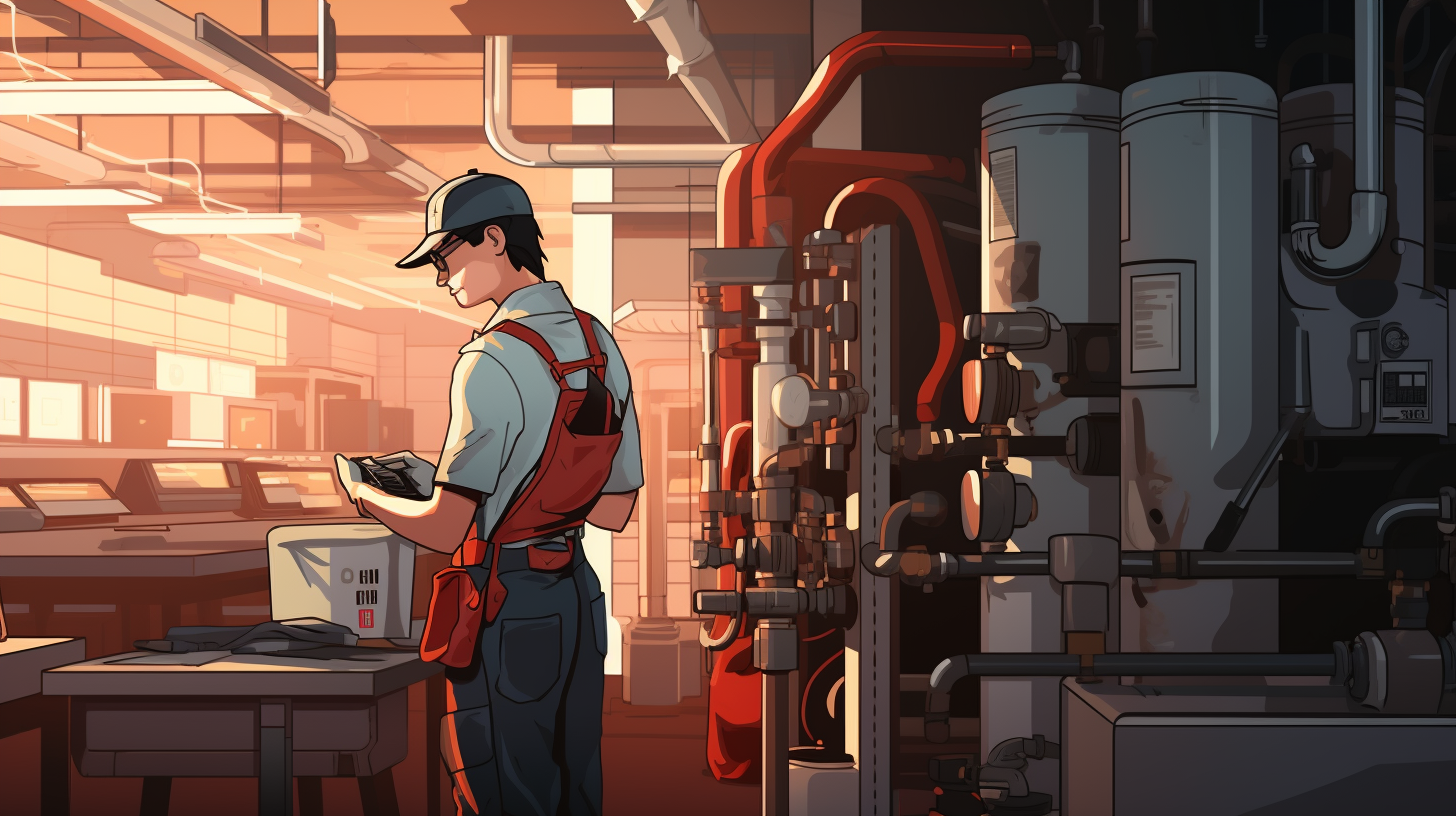We've got you covered with our top 9 safety tips for water heater repairs.
- Wear protective gear to minimize the risk of injury. This includes gloves, safety glasses, and long sleeves to protect your skin.
- Before starting any repair work, shut off the power supply to the water heater. This will reduce the risk of electric shock.
- If you smell gas, immediately evacuate the area and call the gas company. Gas leaks can be extremely dangerous, so it's essential to take immediate action.
- To prevent overheating, make sure to set your water heater's temperature to a safe level. Consult the manufacturer's instructions for the recommended temperature range.
- When working on the water heater, use the proper tools for the job. This will ensure that you can complete the repair safely and efficiently.
- Always follow the manufacturer's instructions when repairing your water heater. They provide valuable information on how to handle specific issues and ensure a safe repair process.
- If you are unsure about any aspect of the repair or feel uncomfortable, it's best to seek professional help. Hiring a licensed plumber can ensure that the repair is done correctly and safely.
- Regularly inspect your water heater for signs of wear and tear. This can help you identify potential problems before they become major issues.
- Finally, keep a fire extinguisher nearby when working on your water heater. Accidents can happen, and having a fire extinguisher readily available can help prevent a small problem from turning into a disaster.
Stay safe and confident while tackling your water heater repairs!
Wear Protective Gear
To ensure our safety during water heater repairs, we must always wear protective gear. This is an essential step in preventing accidents and minimizing the risk of injury.
When working with water heaters, there are various hazards we need to protect ourselves from, such as hot water, steam, and potential chemical leaks. Wearing the appropriate gear, such as gloves, goggles, and heat-resistant clothing, creates a barrier between us and these dangers.
Gloves shield our hands from burns and cuts, while goggles protect our eyes from splashes and debris. Additionally, heat-resistant clothing safeguards our bodies from the intense heat generated by the water heater.
Turn Off Power Supply
After ensuring our safety by wearing protective gear, the next crucial step in water heater repairs is to turn off the power supply. This is an important precautionary measure that must be taken to avoid the risk of electric shock.
Before starting any repair work, it's essential to locate the power source and shut it off completely. This can usually be done by turning off the circuit breaker or switching off the power at the main electrical panel.
It's also advisable to use a voltage tester to double-check that the power has been successfully disconnected. By turning off the power supply, we can ensure a safer working environment and minimize the chances of accidents or injuries during water heater repairs.
Shut Off Water Source
To ensure a safer environment and prevent any potential water damage, we shut off the water source before proceeding with water heater repairs. This step is crucial as it stops the flow of water into the heater, minimizing the risk of leaks or flooding.
Before shutting off the water source, it's important to locate the main water shut-off valve, which is typically found near the water meter or at the entry point of the water supply line. Once you have located the valve, turn it clockwise to shut off the water supply.
It's advisable to drain the remaining water in the system by opening a faucet or drain valve. By following this safety measure, you can confidently proceed with the necessary repairs without the worry of water damage.
Drain the Water Heater
Once we've shut off the water source, the next step in ensuring a safe water heater repair process is to drain the water heater.
Draining the water heater is important because it allows us to remove any remaining water and prevent any potential accidents or damage during the repair.
To do this, we need to locate the drain valve, usually located near the bottom of the tank, and attach a hose to it. We should place the other end of the hose in a safe location where the hot water won't cause any harm.
Once the hose is properly secured, we can open the drain valve and let the water flow out until the tank is completely empty.
This step is crucial to avoid any potential burns or injuries from hot water, so it's important to proceed with caution.
Use Proper Tools
Now that we've drained the water heater, how can we ensure a safe water heater repair process?
One crucial aspect is to use proper tools. When working on a water heater repair, it's essential to have the right tools at hand. This includes wrenches, screwdrivers, pliers, and a multimeter for electrical testing.
Using the appropriate tools not only helps us perform the repair more efficiently but also reduces the risk of accidents or damage. Additionally, it's important to ensure that the tools are in good condition and suitable for the specific task.
We should always follow the manufacturer's instructions and guidelines for using the tools correctly and safely. By using proper tools, we can enhance the safety and effectiveness of our water heater repair work.
Follow Manufacturer's Instructions
In order to ensure a safe water heater repair process, we should always follow the manufacturer's instructions. The instructions provided by the manufacturer are specifically designed to ensure the proper and safe operation of the water heater. They contain important information regarding installation, maintenance, and repair procedures.
By following these instructions, we can minimize the risk of accidents, damages, or system malfunctions. Ignoring or deviating from the manufacturer's instructions can lead to serious safety hazards, such as gas leaks, electrical shocks, or even explosions.
It's crucial that we carefully read and understand the instructions before attempting any repair work. If there are any uncertainties or doubts, it's recommended to consult a professional technician or contact the manufacturer directly for clarification.
Be Aware of Gas Leaks
To ensure our safety during water heater repairs, we need to be vigilant and aware of any potential gas leaks. Gas leaks can be extremely dangerous and can lead to fires, explosions, or even asphyxiation.
When working on a water heater, it's important to check for any signs of gas leaks, such as a hissing sound, a rotten egg smell, or bubbles in the water. If you suspect a gas leak, it's crucial to immediately shut off the gas supply and evacuate the area.
Don't use any electrical devices or create sparks, as this can ignite the gas. It's also important to have a carbon monoxide detector installed near your water heater to alert you of any potential leaks.
Avoid Overheating
Our top safety tip for water heater repairs is to monitor the temperature and prevent overheating. Overheating can lead to serious issues, such as scalding hot water or even explosions. To avoid this, it's crucial to check the temperature settings regularly and ensure they're within the recommended range.
Most water heaters have a thermostat that allows you to adjust the temperature. It's advisable to set the temperature to around 120 degrees Fahrenheit to prevent overheating.
Additionally, consider installing a temperature and pressure relief valve (TPR valve) as an added safety measure. This valve helps release excess pressure and temperature, preventing any potential damage or accidents.
Seek Professional Help if Needed
If we encounter any issues or are unsure about how to proceed with water heater repairs, it's important to seek professional help.
While it may be tempting to try and fix the problem ourselves, tackling water heater repairs without the necessary knowledge and experience can lead to further damage or even injury.
Professional plumbers have the expertise and tools to properly diagnose and fix any issues with our water heater, ensuring that it's repaired safely and effectively. They can also provide valuable advice on maintenance and preventive measures to avoid future problems.
Don't hesitate to reach out to a licensed plumber if we're unsure or uncomfortable with handling the repairs ourselves. It's better to be safe than sorry when it comes to our water heater.
Frequently Asked Questions
How Often Should I Wear Protective Gear When Working on My Water Heater?
When working on our water heater, we should always prioritize safety. Wearing protective gear is crucial to protect ourselves from potential hazards. It's recommended to wear protective gear every time we work on the water heater, regardless of the nature of the repair.
This includes wearing gloves, safety goggles, and appropriate clothing. By consistently wearing protective gear, we can minimize the risk of accidents and ensure our well-being while performing water heater repairs.
What Steps Should I Take to Shut off the Water Source to My Water Heater?
To shut off the water source to our water heater, we need to take a few steps.
First, locate the main water shut-off valve, usually found near the water meter. Turn the valve clockwise to shut off the water supply.
If there's no dedicated shut-off valve for the water heater, we may need to shut off the main water supply for the entire house.
It's important to follow these steps to ensure a safe and successful water heater repair.
Can I Drain the Water Heater on My Own or Should I Hire a Professional?
Can we drain the water heater on our own or should we hire a professional?
It's important to consider the risks involved in draining a water heater. While some homeowners may have the necessary skills and knowledge to do it themselves, it's generally recommended to hire a professional.
They have the expertise to ensure the process is done safely and efficiently. Hiring a professional can provide peace of mind and reduce the risk of accidents or damage.
Are There Any Specific Tools That I Should Use for Water Heater Repairs?
Are there any specific tools that we should use for water heater repairs?
When it comes to repairing a water heater, it's important to have the right tools on hand.
Some essential tools include a pipe wrench, adjustable wrench, screwdriver, multimeter, and a bucket for draining the water.
These tools will help us safely and efficiently troubleshoot and repair common water heater issues.
Remember to always follow proper safety precautions and consult a professional if needed.
Is It Necessary to Follow the Manufacturer's Instructions Even if I Have Prior Experience With Water Heater Repairs?
It's always important for us to follow the manufacturer's instructions, even if we've prior experience with water heater repairs. The manufacturer's instructions are designed to ensure our safety and the proper functioning of the water heater.
Even if we think we know what we're doing, it's crucial to read and follow the instructions carefully. Skipping or disregarding the instructions could lead to accidents, damage to the water heater, or even voiding the warranty.
Conclusion
In conclusion, following these top 9 safety tips for water heater repairs is crucial for your well-being and the proper functioning of your water heater.
By wearing protective gear, turning off power supply, shutting off water source, draining the water heater, using proper tools, following manufacturer's instructions, being aware of gas leaks, avoiding overheating, and seeking professional help if needed, you can ensure a safe and successful water heater repair experience.
Stay safe and enjoy your hot water!



